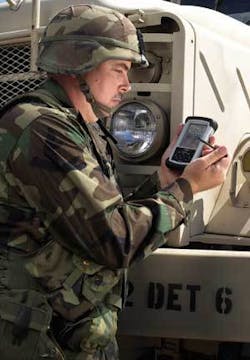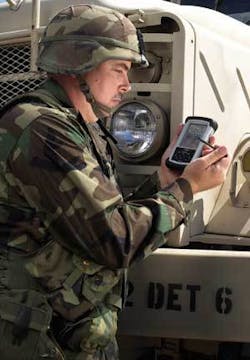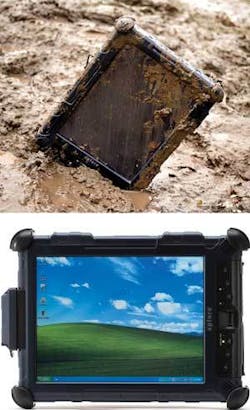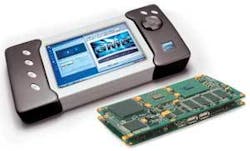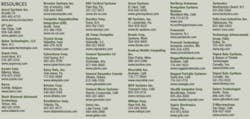Technology companies continue to advance ruggedization and computing technologies to serve the needs of today’s warfighter in the field.
By Courtney E. Howard
Computer systems are central to the U.S. Department of Defense (DOD) network-centric vision, in which all warfighters on the battlefield are essentially nodes in a large connected network. The success of a mission is, in part, dependent on ruggedized computers deployed in the field.
Rugged computers serve a wide variety of functions on the battlefield. First and foremost, they are a means of communication for the warfighter to interact with other soldiers, a commander, and command center. Along those same lines, rugged hardware enables the communication of critical data among soldiers, companies of soldiers, and even across the armed forces.
Such systems are also useful in providing digital situational awareness to warfighters. In fact, Panasonic Toughbook notebook PCs are enabling the soldier to view real-time data that can be presented back to his commander, his staff, and other soldiers on the ground, as part of the Force XXI Battle Command, Brigade-and-Below (FBCB2) program.
“The application provides common pictures of the battle space and graphical displays with not only enemy locations, but also friendly locations, so the soldier has a better understanding of who is out there and whether it’s friend or foe,” says Joe Guest, national account manager for the U.S. Army at Panasonic Personal Computer Co. in Secaucus, N.J., who oversees the sale and service of rugged laptops to the U.S. Army.
Improved situational awareness also lends to more effective target identification. According to Guest, Toughbook 29 and Toughbook 18 ruggedized notebook computers are out in the field providing information about hot spots that need to be hit. “The soldier, when and if needed, can drop his weapons based on information coming off the system,” he explains. The Toughbook unit also provides integrated logistic support to convey warfighters’ transportation needs for such programs as FBCB2.
Functional and flexible
Rugged notebook computers are also employed in the Medical Communications for Combat Casualty Care (MC4) program to impart information related to enemy combatants, digital situational awareness, and medical history and treatment. “In the case of MC4, Toughbook 51 is providing a suite of medical information,” Guest explains. “As a medic or hospital supports casualty care, all the information is transmitted on a Toughbook 51, chosen for its ruggedization and durability. When they’re in these harsh conditions they require something more than your typical laptop that’s plastic or doesn’t have reinforcement on it such as magnesium-alloy protection and shock-mounted hard drives.”
As part of the Biometric Automated Tool Set (BATS) program, rugged laptops support the interrogation of potential terrorists who have been captured in the field. “We’ve deployed approximately 2500 Toughbooks as part of BATS, a complete tool set that goes through the process of interrogating a potential suspect,” says Guest. “They’ve got a camera installed and encryption on the hard drive. Toughbook CF 73s and 74s are used to capture all data received. The system is tied into the network, so as one person is capturing information on a potential suspect, they can pull from other sources, other analysts, and intelligence officers. Having this data pooled is allowing the armed forces to better understand who the suspects are and ensure information captured is available as needed.”
Rugged notebooks are playing a role in supporting unmanned aerial vehicle (UAV) applications. “As spy planes and drones are used in combat situations, and UAVs take surveillance of potential combat areas or suspicious areas, all that information has to come down somewhere,” Guest notes. That UAV uses satellite links that drop data down into a rugged notebook in a portable kit. The U.S. Army’s Raven UAV, for example, delivers UAV data through satellite links into a Toughbook 18 or 19.
And it’s not just rugged notebooks employed in the field. “Rugged servers are being used in nearly every segment of battlefield electronics-fire control, intelligence, surveillance, reconnaissance, and communications,” Scott Kongable, president of Crystal Group in Hiawatha, Iowa, notes. “With nearly every type/class of data transitioning to Internet protocols for net-centric operations, servers are being used for routing and processing mission critical applications-and the number of applications is increasing.”
Military customers are asking for increased computing and storage capacity in smaller footprints, Kongable continues. Customers also have expressed not only the need for higher specified temperatures, but also the desire to deploy custom servers while gaining the benefits of COTS open-computing architecture, to enable rapid and expensive customization and upgrades. Yet, says Kongable, “The most important trait of a rugged server is its reliability in the field. The ability to withstand higher levels of mechanical shock and vibration, as well as operate at maximum computing performance at higher temperatures, results in a higher reliability system for the warfighter.”
Why rugged?
It is clear that even in the past few years, the face of combat has changed. Tensions in the Middle East have brought warfighters-and, as a result, their accompanying computer systems-into urban environments under harsh conditions that pose a serious threat to electronics.
“Customers are deploying into a lot more environments than they ever have in the past, with IT technology and systems that typically 10 years ago would never have survived in these conditions, whether it’s a cave in the mountains of Afghanistan or the deserts of Iraq with the fine sand and dust,” Guest says. “Operation Iraqi Freedom has really tested laptops in general. If the hard drive is going to crash if dust and dirt can get inside the system, if it’s not a fully ruggedized unit, it is really of no use to today’s warfighter in the field. The system is not simply just a laptop, it’s a tool for completing the mission and a mission today depends on life and death; I think that’s where our customers are realizing they simply can’t buy a $1,000 commercial computer system when it comes to the applications, the missions, and the environments that soldiers are in today.”
Ruggedization protects the computer system in, among others, three critical areas. The areas of a laptop most commonly damaged are the LCD screen, the hinges, and the hard drive. When Panasonic launched its first Toughbook 25 a decade ago, for instance, engineers ensured it was encased in magnesium and integrated a shock-mounted hard drive and LCD hinges made of magnesium. “Along with the complete shell that was magnesium, the hinges were reinforced and, internal to the system, we had flex connectors on the hard drive,” Guest explains. “The hard drive is typically mounted directly to the motherboard; our approach was to use a flex connector, so when that system did get dropped or banged around a little bit-which no matter how careful you are, that’s going to happen-it had a bit of give to it.”
One of the key benefits of ruggedization is reliability. Warfighters in the field need to know that, despite extreme temperatures and conditions, their computer systems will be available when they need it. “First and foremost, it’s reliability that they are looking for,” Guest says. “The fact that systems are ruggedized with shock-mounted hard drives lends to reliability. Toughbooks average less than 5 percent failure rates, whereas average failure rates are between 20 and 30 percent, according to published Gartner Group statistics.
“One of the things the industry is always focused on in terms of ruggedized systems in the field has been the need for better view ability in direct sunlight,” Guest notes. As a result, Panasonic began shipping its new Toughbook CF 30 last month, which introduces a 1,000-nit display. “The true benefit that provides is that the soldier who is sitting out in the deserts of Iraq-when he has that laptop in front of him and he’s looking at information related to FBCB2, friend vs. foe, and his digital situational awareness on the battlefield itself-needs to be able to see that screen. When you have a system in direct sunlight, any other display would wash out-specifically a commercial-grade laptop - but the CF 30 display is just as bright in direct sunlight as it is sitting in an office.
“In the military and even in the commercial space, people need to do things faster,” says Guest. “Technology has allowed us, whether it’s a soldier in the field or someone working in an office environment, to increase performance.”
Military customers want to reach the ceiling of performance, combined with the reliability of ruggedization. Similarly, military users require expanded memory capacity, given the amount and size of data they require. Other features requested by military customers include integrated GPS, with which to track coordinates, and security, such as the Trusted Platform Module (TPM) that enables greater system authentication and encryption. Along that line, the use of integrated smart cards in ruggedized computer systems, a longtime topic of conversation in military environments, is becoming a reality. From a security standpoint, integrated smart cards enabled log-in authentication to gain access to the system overall and to specific data. Panasonic incorporated the smart card into its latest rugged laptop based on feedback from military personnel, and conversations between the company’s research and development engineers and contacts at the Defense Manpower Data Center (DMDC), Department of Defense, in Seaside, Calif.
Just as rugged computers are becoming more advanced, customers are becoming much more technology savvy. Military customers, and even military contractors, are not just looking for a computer with a faster processor speed or larger hard drive. One of the first things they want to see is that a system meets all MIL-SPEC requirements, especially MIL-STD-810F that indicates its ability to withstand shock, humidity, high and low temperature ranges, water resistance, dust, and droppage. Additional requirements related to those environments include MIL-STD-461E for electromagnetic interference (EMI), and Class 1, Div. 2, UL1604 for spark emissions. To allay customer concerns, Panasonic has its Toughbooks independently tested by Southwest Research Institute (SwRI), a common electronic testing facility in San Antonio, Texas.
Size sensibilities
Increasingly, military customers are seeking complete, integrated solutions in a small form factor. “They want to go beyond where we’ve been in the past with a laptop,” Guest admits. “The type of combat they face today is a lot different that what we faced 10 years ago. Today they’re in Baghdad, but during Desert Storm, it was all aircraft-we didn’t have to put soldiers in the situations they are in today, in the high-risk environment of an inner city, urban war. The system in that Humvee or that Striker needs to be a complete solution.” As a result, attention is turning to more portable, and even handheld, systems. For this reason, the Special Ops community has adopted the four-pound Panasonic Toughbook 19 convertible tablet PC, in their rucksack and in their vehicles, such as the Humvee, says Guest. “That’s where the industry is going-small, portable, compact. There still is a need for larger systems-that’s always going to be there-but smaller continues to be a requirement.”
Warfighters are largely requesting handheld computer systems, but a commercial-off-the-shelf (COTS) PDA device cannot withstand battle environments like Iraq. “A COTS PDA device isn’t going to survive a normal Army environment even at Fort Bragg, let alone the conditions of Iraq,” says Guest. “That is why we’re right now researching and talking to our customers about creating a handheld that will meet their needs from a performance standpoint, but also be able to operate in the conditions of Iraq.”
Ruggedized handheld computer systems for military use are available from such companies as General Micro Systems in Rancho Cucamonga, Calif.; Tripod Data Systems of Trimble Technologies in Corvallis, Ore.; Xplore Technologies of Austin, Texas; Black Diamond Advanced Technology in Tempe, Ariz.; and others. In fact, according to Ben Sharfi, CEO and president of General Micro Systems, 11,000 units of the company’s P630 Spartan PR Intel Pentium-based rugged handheld computer have been deployed to date. Moreover, the company delivers its P640 to L-3 Communications in San Diego, Calif.; the P640 has been deployed in the United Kingdom.
Rugged handheld computers have several applications in military environments, says Dale Kyle, product manager for rugged handheld computers for the TDS division of Trimble. “Medical personnel use them to identify soldiers. Logistics personnel use them to track containers and equipment via barcode and GPS information. They also use the handhelds to configure stow plans for cargo ships. They’re used for IP chat over tactical radio systems, and for loading radio frequencies onto aircraft. Snipers use the handhelds for ballistic software, and other soldiers use the handhelds to keep information organized. The Marine Corps has mounted rugged handhelds in its Humvees as part of a larger, classified system. Additionally, a number of military contractors use rugged handhelds in the field,” he says.
“The military is looking to use handheld units as two-way, real-time speech translators,” Sharfi continues. “Troops overseas can talk real time and it’s translated to Arabic, whereas the Arabic is translated in real time to English. The handheld computer, such as the GMS P630 Spartan PR, has so many applications on the battlefield, on the soldier or vehicle mounted, including health monitoring of the warfighters, electronic mind fields, surveillance, robotics, night vision and collision avoiding, radio and video communications, and so on.”
“According to Venture Development Corp. in Natick, Mass., government expenditures on rugged mobile computers represent the largest portion of the revenue potential for this market,” says Patrick Gray, director of product marketing, Xplore Technologies. “Rugged tablet PCs is the fastest growing segment in the large-form-factor rugged mobile computing market. From these overall market trends, it is easy to surmise that more rugged tablet PC systems will be utilized in the field.” And, given that smaller-form-factor handheld computers offer lower power consumption and longer battery life, low weight, and the ability to fit in a warfighter’s pocket, chances are good that more and more of the units will find their way onto the battlefield.
null
